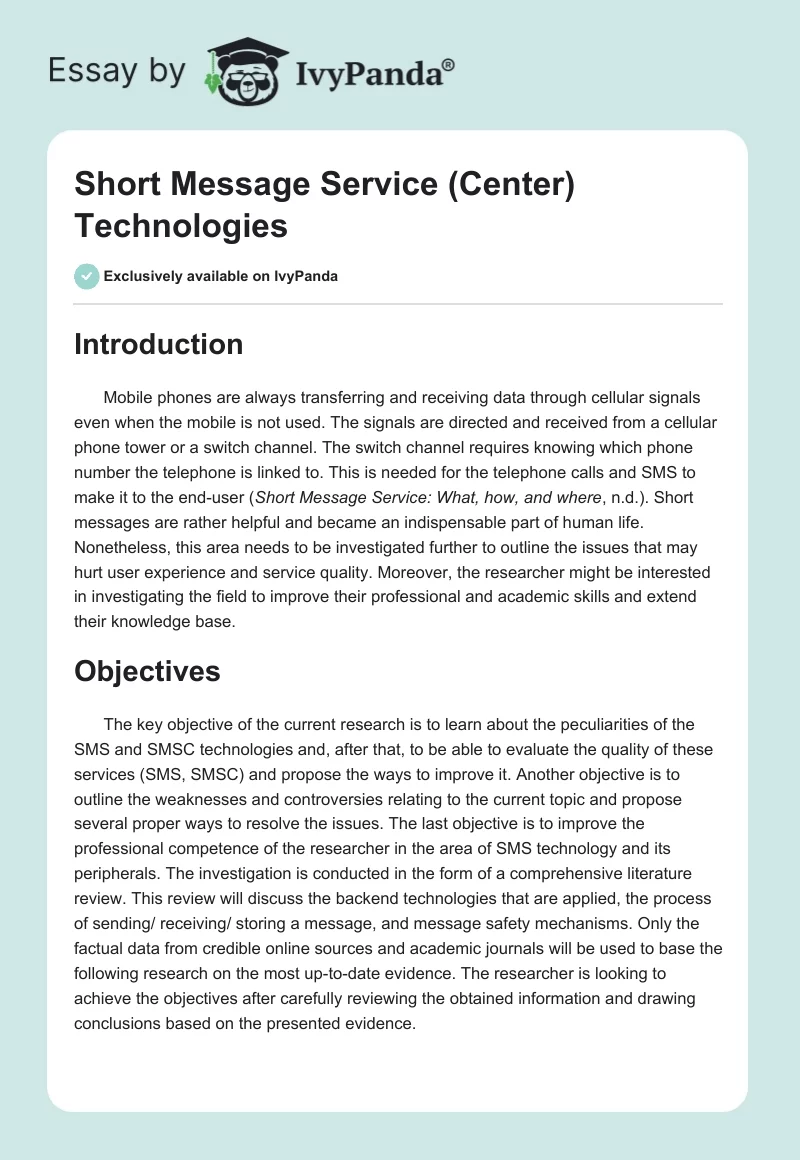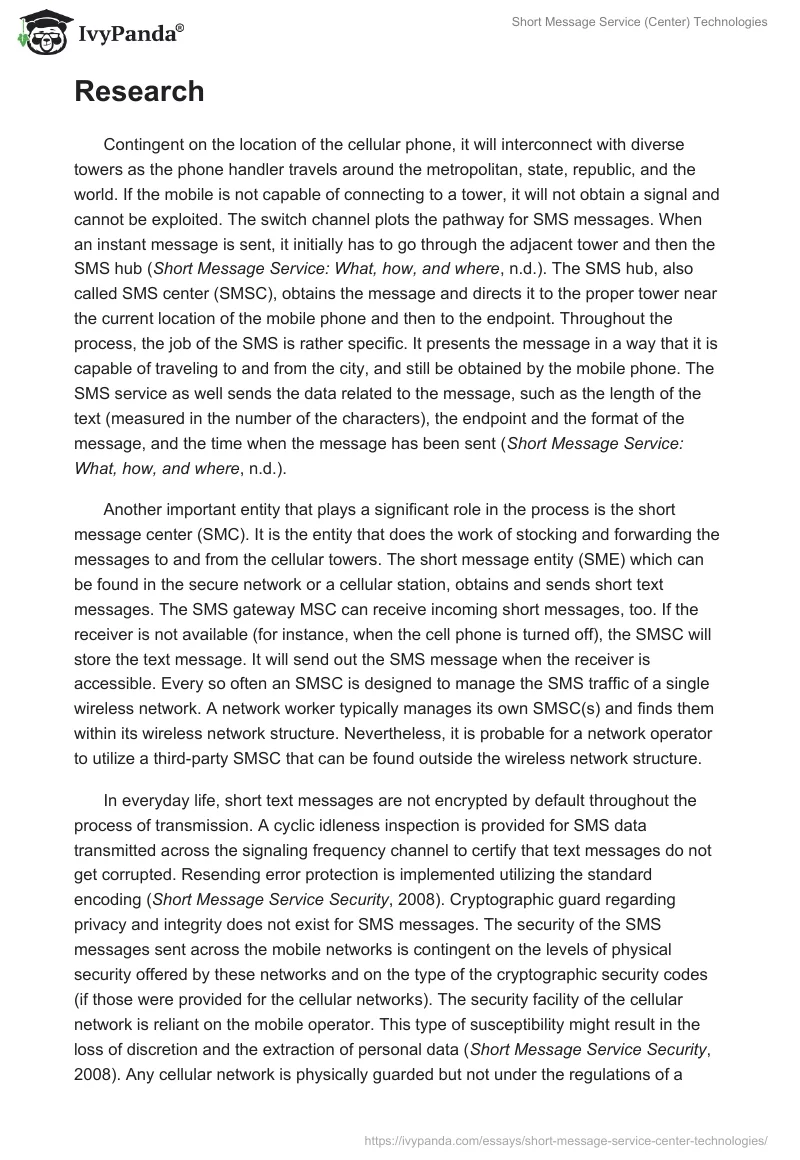Introduction
Mobile phones are always transferring and receiving data through cellular signals even when the mobile is not used. The signals are directed and received from a cellular phone tower or a switch channel. The switch channel requires knowing which phone number the telephone is linked to. This is needed for the telephone calls and SMS to make it to the end-user (Short Message Service: What, how, and where, n.d.). Short messages are rather helpful and became an indispensable part of human life. Nonetheless, this area needs to be investigated further to outline the issues that may hurt user experience and service quality. Moreover, the researcher might be interested in investigating the field to improve their professional and academic skills and extend their knowledge base.
Objectives
The key objective of the current research is to learn about the peculiarities of the SMS and SMSC technologies and, after that, to be able to evaluate the quality of these services (SMS, SMSC) and propose the ways to improve it. Another objective is to outline the weaknesses and controversies relating to the current topic and propose several proper ways to resolve the issues. The last objective is to improve the professional competence of the researcher in the area of SMS technology and its peripherals. The investigation is conducted in the form of a comprehensive literature review. This review will discuss the backend technologies that are applied, the process of sending/ receiving/ storing a message, and message safety mechanisms. Only the factual data from credible online sources and academic journals will be used to base the following research on the most up-to-date evidence. The researcher is looking to achieve the objectives after carefully reviewing the obtained information and drawing conclusions based on the presented evidence.
Research
Contingent on the location of the cellular phone, it will interconnect with diverse towers as the phone handler travels around the metropolitan, state, republic, and the world. If the mobile is not capable of connecting to a tower, it will not obtain a signal and cannot be exploited. The switch channel plots the pathway for SMS messages. When an instant message is sent, it initially has to go through the adjacent tower and then the SMS hub (Short Message Service: What, how, and where, n.d.). The SMS hub, also called SMS center (SMSC), obtains the message and directs it to the proper tower near the current location of the mobile phone and then to the endpoint. Throughout the process, the job of the SMS is rather specific. It presents the message in a way that it is capable of traveling to and from the city, and still be obtained by the mobile phone. The SMS service as well sends the data related to the message, such as the length of the text (measured in the number of the characters), the endpoint and the format of the message, and the time when the message has been sent (Short Message Service: What, how, and where, n.d.).
Another important entity that plays a significant role in the process is the short message center (SMC). It is the entity that does the work of stocking and forwarding the messages to and from the cellular towers. The short message entity (SME) which can be found in the secure network or a cellular station, obtains and sends short text messages. The SMS gateway MSC can receive incoming short messages, too. If the receiver is not available (for instance, when the cell phone is turned off), the SMSC will store the text message. It will send out the SMS message when the receiver is accessible. Every so often an SMSC is designed to manage the SMS traffic of a single wireless network. A network worker typically manages its own SMSC(s) and finds them within its wireless network structure. Nevertheless, it is probable for a network operator to utilize a third-party SMSC that can be found outside the wireless network structure.
In everyday life, short text messages are not encrypted by default throughout the process of transmission. A cyclic idleness inspection is provided for SMS data transmitted across the signaling frequency channel to certify that text messages do not get corrupted. Resending error protection is implemented utilizing the standard encoding (Short Message Service Security, 2008). Cryptographic guard regarding privacy and integrity does not exist for SMS messages. The security of the SMS messages sent across the mobile networks is contingent on the levels of physical security offered by these networks and on the type of the cryptographic security codes (if those were provided for the cellular networks). The security facility of the cellular network is reliant on the mobile operator. This type of susceptibility might result in the loss of discretion and the extraction of personal data (Short Message Service Security, 2008). Any cellular network is physically guarded but not under the regulations of a single unit. The protection of the cellular network against the message theft is, therefore, only as efficient as the feeblest protection presented by any of the mobile operators since the text messages can be stolen into the frailest point of access.
Product
A comprehensive literature review will be the final result of the current research. The investigator is motivated to dwell on the controversies inherent in the SMS and SMSC technologies and present reasonable evidence concerning the gaps in those technologies. This will be done to review the ways of how the technologies (and services contingent on the SMS/ SMSC) could be improved and re-evaluated. The investigator also expects to find the variables that affect the performance of the network and dedicated SMSC services. The challenge of the current research is to identify the gaps in the user experience, performance level, and service quality.
Evaluation
In this literature review, the researcher looks to evaluate the current state of affairs in the SMS/ SMSC field. This is rather reasonable for the reason that the problem of the rapidity of sending and receiving text messages and the security of the sent information remain serious issues. Numerous factors should be taken into consideration when concluding the eminence of the SMS/ SMSC services and the amount of the information that this literature review will cover. A thorough evaluation of the results will take one week. From the evaluation, the investigator expects to find out the areas that need attention when it comes to the consistency of the evaluated service and the most evident drawbacks that might become the potential ways to improve the performance.
Project Plan
The project plan is presented by a timetable that outlines the project schedule day by day (Figure 1). The plan presupposes that the literature review will be the most time-consuming task of the project. The evaluation of the results and formulation of the conclusions will be the last steps of the research project. These two are intended to finalize the process and provide the reader with an inclusive report dwelling on the SMS/ SMSC services, the implications connected to these two, and the modifications that might be made to the current methodology.

References
Short Message Service: What, how, and where (n.d.). Web.
Short Message Service Security (2008). Web.


